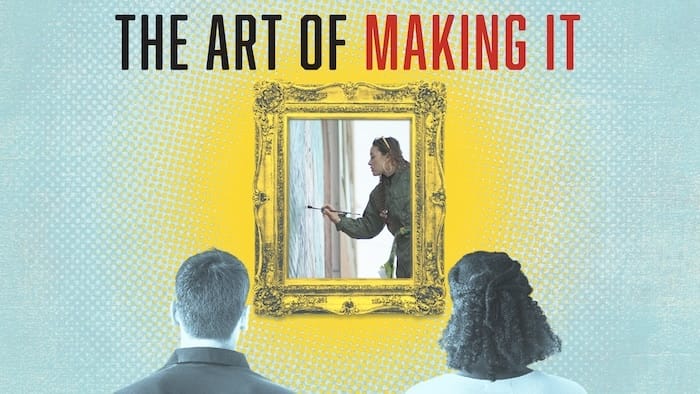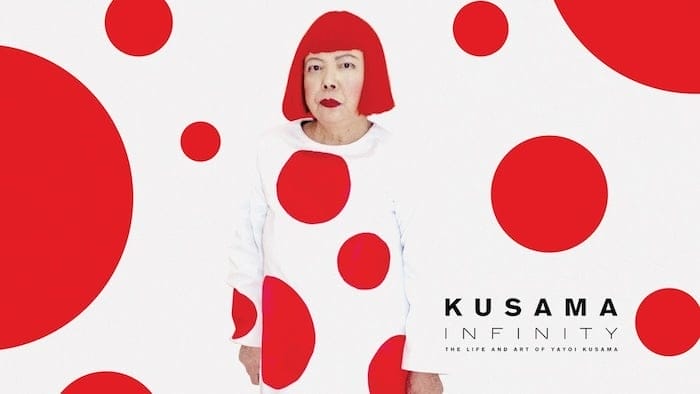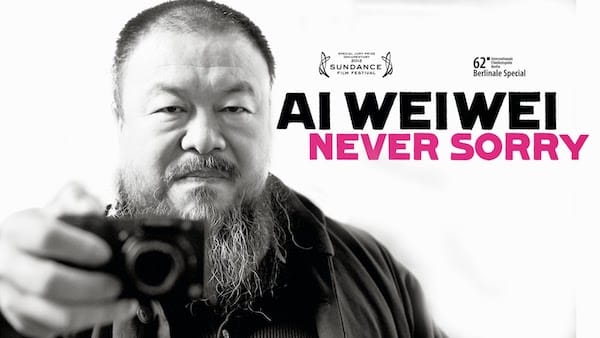Put the art world in focus with this curated list of best art documentaries, including new releases and old favorites. Featuring visionaries from up-and-coming creatives to iconic figures, these award-winning films shine a spotlight on our favorite artists, reveal untold history, and dive into what it takes to make it as an artist today. Our updated list now features even more suggestions, so get ready to add these documentaries to your playlist of things to watch for creative inspiration.
Top 13 Best Art Documentaries

Kelcy Edwards’ documentary delves into the lives of a diverse group of up-and-coming artists, including Jenna Gribbon, Felipe Baeza, Gisela McDaniel, and Chris Watts, as they navigate the complexities of the modern art world. The film explores who gets to “make it” in today’s art world — and how they get there.
With appearances from both establishment figures and emerging artists, this film peers into the exclusive, elusive, and opaque art world from an outsider’s perspective and provides a rare, unfiltered view into the lives and struggles of emerging artists.
By examining the factors contributing to the artists’ successes and failures, Edwards encourages viewers to reflect on their own creative journeys and their place within the art world. From confronting the challenges of establishing a unique artistic voice to overcoming financial and logistical hurdles, the film offers valuable insights and lessons for aspiring artists.
In this HBO documentary directed by Sam Pollard, the landmark LACMA exhibition “Two Centuries of Black American Art,” curated by the late David Driskell, is the focal point for exploring the rich and diverse contributions of Black artists to the contemporary art scene. Featuring prominent figures like Theaster Gates, Faith Ringgold, Amy Sherald, Kara Walker, Kehinde Wiley, and Carrie Mae Weems, the film celebrates the achievements and resilience of African American artists throughout history.
By showcasing the work and experiences of these trailblazing artists, the documentary aims to challenge and dispel the widespread misconceptions and prejudices that have historically marginalized Black creatives within the art world. The film uses a combination of archival footage, personal anecdotes, and expert commentary to show the unique challenges Black artists have faced and the strategies they have employed to overcome them.
From graphic design to architecture, set design to photography, and more, this Netflix series steps inside the minds of innovative designers at the top of their fields. Featuring renowned figures like Bjarke Ingels, Ruth Carter, Christophe Niemann, and Ilse Crawford, the two-season series explores how design concepts are translated into everyday life, highlighting the interconnectedness of art and functionality.
Each episode provides a fascinating glimpse into these visionary designers’ artistic sensibilities and techniques, revealing their sources of inspiration and challenges in realizing their creative visions. By showcasing the diverse ways in which design can be harnessed to solve problems, evoke emotions, and transform spaces, the series encourages artists to push their work’s boundaries and consider the broader implications of their creative endeavors.
The Price of Everything (2018)
The Emmy-nominated HBO documentary, directed by Nathaniel Kahn, examines the often controversial relationship between art and money. The film juxtaposes the divergent career trajectories of Larry Poons, a former art darling of the 1960s who pivoted away from his commercially successful paintings to focus on his artistic vision, and Jeff Koons, whose factory-like studio with teams of assistants produces high-priced artworks that sell for millions. By interviewing key players, including collectors, art-world insiders, and artists like Poons and Koons, the film raises important questions about the factors determining an artist’s success and the role of money in shaping artistic value.

Yayoi Kusama is one of the world’s most successful living artists today, thanks in no small part to social media. She commands top prices while her immersive exhibitions draw more museum crowds than any other. But for decades, she toiled in semi-obscurity as other creatives, from Claes Oldenburg to Andy Warhol, drew more attention to similar ideas. Her boundary-pushing work as a female Japanese artist and her struggles with mental illness led to her exclusion from her family, home country, and the art world writ large. “I transformed my trauma into art,” the prolific artist says in this documentary that charts her endurance through it all.
This documentary follows renowned performance artist Marina Abramović as she plans her groundbreaking retrospective at the Museum of Modern Art. The film provides an intimate look at the artist’s creative process, revealing how she uses her body as her medium to create physically and psychologically demanding performances that push both her and her participants to their limits.
Through behind-the-scenes footage and interviews, the documentary explores the motivations and inspirations behind Abramović’s boundary-pushing work, offering valuable insights for artists interested in exploring the potential of performance art. By examining how Abramović challenges conventional notions of art, the film encourages viewers to rethink their artistic boundaries and consider art’s potential as a catalyst for personal growth and transformation.
“Ai Weiwei: Never Sorry” (2012)

Art as activism gets its due in this feature on Chinese conceptual artist Ai Weiwei, who gained international fame for his courageous efforts to expose the injustices of his native country’s authoritarian government. The film follows Weiwei over three years, capturing his confrontations with government officials, his innovative use of social media to raise awareness and the creation of his provocative and politically charged artworks.
The artist behind such famed works as “Dropping a Han Dynasty Urn” (1995) endures detention, beatings, and censorship on behalf of Chinese officials as he creates “The Sichuan Earthquake Names Project,” which posted 5,000 victims’ names from a May 2008 earthquake in Sichuan to his blog, and “Sunflower Seeds” (2010), an installation at the Tate Modern made up of ten tons of handmade porcelain sunflower seeds.
The documentary serves as a powerful reminder that art can inspire social change and challenge oppressive systems of power. For artists seeking to use their work as a platform for activism, the film provides valuable insights into the strategies and sacrifices required to make a meaningful impact on the world.
Allegedly directed by the elusive street artist Banksy, this Oscar-nominated film blurs the line between fact and fiction as it follows a street art enthusiast attempting to make a name for himself in the international art scene. Featuring urban artists like Shepard Fairey, Invader, Poster Boy, and Banksy himself (blurred and distorted to protect his then-anonymity), the plot’s surprising twists and turns will leave you guessing whether it’s just another of the artist’s hoaxes – or the best art documentary ever made.
The documentary serves as an intriguing examination of the motivations and strategies of street artists, exploring the complex dynamics of fame, authenticity, and creative expression within the street art community and how art has the potential to transform urban environments.
This intimate documentary, created by Basquiat’s friend and filmmaker Tamra Davis, offers a rare glimpse into the life and career of the iconic artist. The film chronicles his rapid rise to fame, his relationship with Andy Warhol, and the struggles artists of color face in a predominantly white art world. By exploring Basquiat’s enduring legacy and the unique circumstances of his life and career, the film offers inspiration and guidance for artists seeking to break through barriers and create meaningful, lasting work.
This heartfelt documentary follows the life and work of legendary New York Times street-style photographer Bill Cunningham, who spent decades chronicling the city’s ever-evolving fashion landscape. Vogue editor Anna Wintour once said of the 80-year-old artist who died in 2016, “We all get dressed for Bill.”
The film follows Cunningham as he roams the streets of Manhattan on his bicycle, capturing candid moments and unique characters that embody the spirit of New York. Through interviews with friends, colleagues, and the photographer, the documentary reveals the deeply held beliefs and personal philosophy that shaped Cunningham’s singular approach to fashion, photography, and life.
By showcasing the photographer’s unwavering dedication to his craft and his ability to find beauty and inspiration every day, the film serves as a poignant reminder of the importance of passion, perseverance, and authenticity in pursuing artistic excellence.
Directed by Corinna Belz, “Gerhard Richter Painting” offers a rare look into the creative process of one of the world’s most renowned contemporary artists. The documentary captures Richter at work in his studio, providing viewers with a unique opportunity to observe his meticulous approach to painting and the evolution of his artworks from the initial concept to the finished piece.
The film explores Richter’s thoughts on the nature of art, inspiration, and the creative process. By examining the intersection of technique, intuition, and imagination, “Gerhard Richter Painting” encourages viewers to consider the myriad factors contributing to creating compelling, evocative art.
“Finding Vivian Maier” is a fascinating documentary that unravels the mystery of the late street photographer Vivian Maier, a nanny who secretly took over 100,000 photographs during her lifetime. Maier’s incredible body of work, discovered after her death, has since gained international acclaim for her striking compositions and unique expression of mid-20th-century American life.
Through interviews with those who knew her and extensive examination of her photographs and personal artifacts, the film explores the enigmatic figure’s life, art, and the circumstances that led to her work remaining hidden for decades.
Directed by Lisa Immordino Vreeland, “Peggy Guggenheim: Art Addict” chronicles the life of one of the most influential art collectors and patrons of the 20th century. The film traces Guggenheim’s journey from her privileged upbringing to her self-imposed exile in Europe, where she established herself as a central figure in the modern art movement, supporting and promoting artists such as Jackson Pollock, Max Ernst, and Marcel Duchamp.
The documentary reveals Guggenheim’s unwavering commitment to advancing contemporary art and the significant impact of her patronage on the art world. “Peggy Guggenheim: Art Addict” inspires artists seeking to forge connections and find support within the art community.
________________
These 13 art documentaries offer a wealth of inspiration, insight, and guidance for artists and art lovers seeking to better understand the art world and their place within it. By exploring the lives and works of diverse artists across various disciplines, these films encourage viewers to reflect on their creative careers and find new avenues to success.
If you liked this, check out 5 Visually Stunning Movies Inspired by Art Masterpieces.
Which art documentaries are your favorites? Share with us in the comments.
